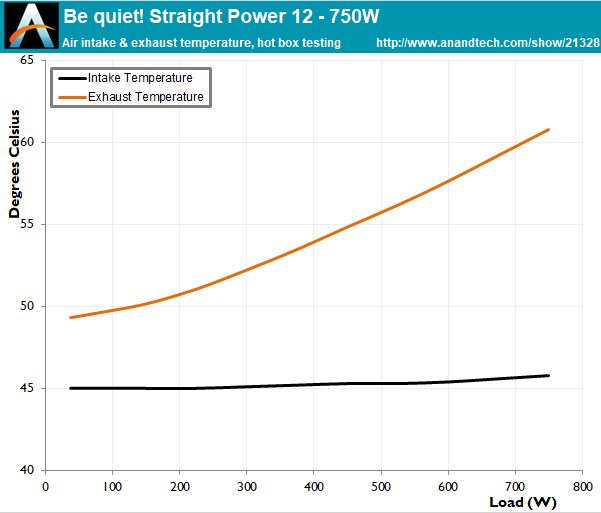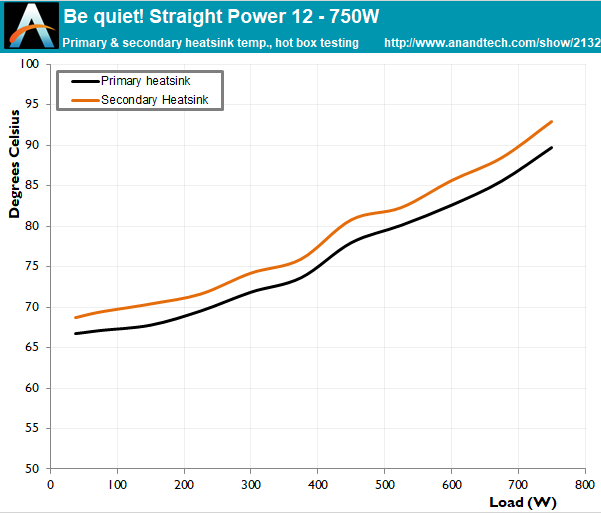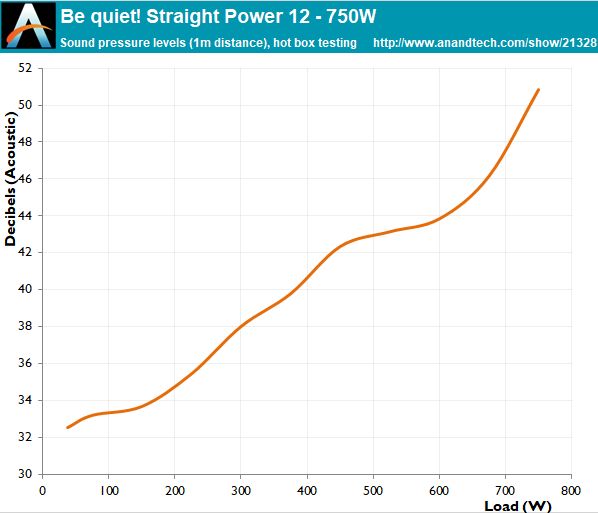The be quiet! Straight Power 12 750W PSU Review: Proficient Platinum Power
by E. Fylladitakis on April 5, 2024 8:00 AM EST- Posted in
- Cases/Cooling/PSUs
- PSUs
- 750W
- be quiet!
- 80Plus Platinum
Hot Test Results (~45°C Ambient Temperature)
In our elevated ambient temperature test, the Be quiet! Straight Power 12 750W PSU experiences a notable dip in efficiency, dropping to an average of 90.6% under a 115 VAC input and 92% with a 230 VAC input. Despite this marked decrease from its optimal performance levels, the PSU remarkably exhibits no thermal stress indicators, even when operating at its maximum capacity.
The Be quiet! Straight Power 12 750W PSU's fan operates with a controlled strategy, ramping up as needed to manage thermal output. Despite the very high ambient temperature, the speed of the fan is fairly low when the unit is lightly loaded, maintaining comfortable noise figures. This is achieved via the PSU's large heatsinks and its efficiency levels that surpass the norm for its category, leading to superior thermal management. Despite the fan's increased speed under heavy loads, the noise remains manageable with a constant load of up to 600 Watts, striking a fine balance between cooling effectiveness and noise control across most of its operating spectrum. While the fan becomes more audible with heavier loads, the internal temperatures remain remarkably low, evidencing the unit's adept balance between thermal regulation and acoustic performance.
As the fan accelerates under the thermal control system's command in the Be quiet! Straight Power 12 750W PSU, the unit adeptly regulates its internal temperatures, keeping them commendably low for its category. Still, the low internal temperatures would suggest that the designer had more headroom to lean towards low-noise operation at the expense of some thermal performance. In situations where the load exceeds 90%, the thermal control circuitry prompts the fan to reach its highest speeds, while the internal temperatures are far from the OTP trigger point. This is adeptly calculated for a top-tier performance PSU, where the designer wants to make sure that there will be no thermal stress reducing the performance of the active components while the PSU is heavily loaded, especially with a design that is likely to have to combat heavy power excursions from a gaming GPU.















32 Comments
View All Comments
PeachNCream - Sunday, April 7, 2024 - link
It's safe to say there are more than PSUs, CPU coolers, and external storage devices worth reviewing. Companies still produce and sell laptops, phones, *graphics adapters (integrated and discrete)* and so forth. Might be good for Ananadtech to nudge Future about getting permission to write those sorts of reviews or it really will be nailing the coffin closed on the "AT suddenly redirects to THG and no one is surprised" outcome lots of us are expecting - just a thought from a couple decades-long reader in light of what the front page looks like two days after yet another power supply review loiters at the top with little acknowledgement it was even posted. Replyballsystemlord - Monday, April 8, 2024 - link
I'm not sure it's due to Future or the lack of staff at AT. Ian was the latest to leave and he's now doing his own YT channel, so it seems he wants to continue to contribute to the tech news readers. ReplyPeachNCream - Monday, April 8, 2024 - link
Future would have to invest in AT ad actually hire staff. It's pretty clear given that the writers are publishing on THG as well that this is a secondary interest at best and changes are afoot too. When a company only reviews samples its provided, it become beholden to them. There's something to be said about leveraging the budget a bit to buy things off the shelves when there isn't a much-hyped NDA deadline.As for Ian - well it's best to leave that hot mess unmentioned. Reply
GeoffreyA - Tuesday, April 9, 2024 - link
I think it would be great to see more general tech and science topics reported on as well. Just a few paragraphs on the latest dark energy news, Google's Jpegli, etc. ReplyGeoffreyA - Tuesday, April 9, 2024 - link
Also, though I understand it might not be possible at present, YouTube would a good, and necessary, way to diversify. Many go first to videos for news these days. ReplyTheinsanegamerN - Tuesday, April 9, 2024 - link
The writing has been on the wall for a LONG time. Many of us called it when AT used the "california fire burned staff member house" excuse for why they could no longer do GPU reviews. They had "plans" to fix things, and apparently either that staff member never got a new house or AT just gave up.When you cant review tech because your company relies on home setups to test things, that says a LOT. AT has been a minor tech site for years, and with the loss of actual technical breakdowns, has little reason to exist.
Within 5 years, if AT still exists, it will be just a content mill, "aggregating" reviews from other sites. Hell look at this comment section, straight out of 2001. They have no interest in maintaining the site. Reply
GeoffreyA - Tuesday, April 9, 2024 - link
If AT could get free from its rotten publisher, get funding and more staff, things can turn around. AT was doing all right, but Ian seems to have spirited away their high-profile connections. ReplyPeachNCream - Tuesday, April 9, 2024 - link
Fine, let's open the Ian box. I think he was a good writer, but he also left many of us with the impression that he sold out to whomever it was that owned Killer NICs before Intel - Qualcomm IIRC - by selling the benefits of packet prioritization from from the assorted programs on the local machine to improve game performance. He 100% ignored the fact that once said packets leave the PC's local adapter, they are give no priority whatsoever through the dozens of traffic-agnostic routers and potentially thousands of miles of copper and optical fiber said data traverses to and from the game host. That prioritization ends at your ISP's hardware for a home user. He inexplicably foot-stomped those benefits without either a) understanding the most basic networking concepts and b) explaining why he was enamored and abusing the public-facing nature of his position at AT to spread what was at best a non-beneficial product. Given Killer's crappy software stack and Qualcomm's bad driver writing at the time along with garbo hardware, it was potentially a disservice to readers to end up with inferior networking hardware. The fact that he's gone off to chase that content creator gamble dream on YouTube is to *great* benefit of AT. Good riddance and despite the quality writing, no one needed that level of misdirection.Should AT transition to video? Maybe, but with clear limitations on budget and the need for what are effectively small production studios to make the leap in a competitive manner, it's not positioned to play catch up and Future probably has no appetite for it anyhow. They're just milking the money cow until it's skeletal and moving on like locusts to the next thing. Sucks for the employees and for the readers, but that's reality when profit not passion drives a publisher. Reply
ballsystemlord - Tuesday, April 9, 2024 - link
I think you're being a bit too harsh on Ian. The Ethernet in your computer isn't really something users normally have control over. No mass shopping site that I know of even has a toggle for which Ethernet chipset the motherboard supports. It's important, but not really vital.Worth noting is that he alone, of all tech reviewers, interviewed many of the developers of our chips. Granted, I think he could have asked better questions in some cases, but that's what we got from his skill set.
Additionally, Ian also developed some of the SW used to test CPUs for AT. I actually found his test code base, and it's revamped version, to be interesting benchmarks for how poorly written, vs. well written, code behaved on different CPUs and arch-es. Reply
GeoffreyA - Wednesday, April 10, 2024 - link
While Ian did interview many high-profile developers, and contributed a great deal to AT, I think his writing was obscure and too detailed. Anand, in contrast, made computers exciting: one was kept on the edge of one's seat as he took the reader through the innards of the CPU. He had an abstraction and made it accessible to the layman. And who can forget those memorable titles? It's Judgment Day, The Empire Strikes Back, AMD on the Counterattack, and if I remember rightly, the P4's heatsink was "Mount Everest." His words still linger on when I think of CPUs. Reply